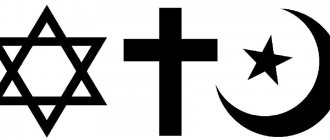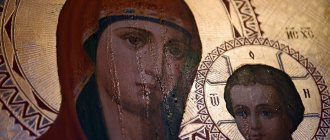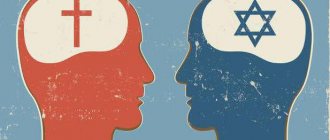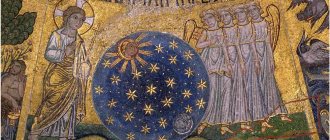Hello, dear readers of the Tyulyagin project! Today we will talk about most numerous religions in the world. Regardless of what faith you belong to and whether you are a believer or not, it is necessary to give religions their due and recognize the fact that throughout human history they have had and are having a huge influence on human activity, development and culture. In this article we will talk about modern religions and which of them are the most numerous and widespread in today's world.
The emergence of Christianity
Christianity arose on the basis of Judaism and was initially regarded as a sect.
What is the difference between Jews and Christians? Judaism is the national religion. The basis of the teaching is the chosenness of the Jewish people. Christianity is a world religion. It unites all followers of Jesus Christ.
The difference lies in how Christians pray. Of course, prayer is part of spiritual practice in all religions. However, their lyrics and performance are significantly different. There are several prayer rules in Christianity. There are no obligatory prayers in Judaism.
The meaning of faith
Faith in the life of a Christian is a gift from God. Having taken the path of faith, a person gets rid of his shortcomings, gradually transforming into the image of Christ. The most important commandments for Christians are to love God and neighbor. They combine 10 Old Testament instructions that became the basis of Christianity. The New Testament commandments define how a Christian should live. However, their implementation must be a voluntary decision.
The holy book of Christians is the Bible. It includes a series of ancient books that were created over 15 centuries. The Bible consists of two parts:
- Old Testament – 39 books;
- New Testament – 27 books.
The Christian cross serves as the main symbol of faith. It represents the instrument of Christ's execution. The cross reminds us of the savior’s sacrifice for the sake of people and eternal life.
The life of a Christian is connected with a temple or other place intended for worship and church sacraments. Temples include places of worship that have an altar.
Types of Islam
Adherents of Islam are not united in their ideas about the true faith. There are two main schools of religion: Shiites and Sunnis. Disagreements between them arose almost immediately after the death of the prophet. The basic tenets of Islam (the unity of God, belief in life after death, hell and heaven, they eat beef and lamb and do not eat pork) are not questioned by either one or the other. The disagreements lie in the area of interpretation and enforcement of religious dogmas.
Sunnis (according to statistics, Muslims make up 85-90% of the total number of believers), along with the Koran, revere the Sunnah, emphasize the need to follow the sayings of the Prophet Muhammad and believe in the predestination of everything. They also deny freedom of choice, revere traditions, and participate in the election of the head of their community - the caliph. Within the Sunni direction there are a number of sects (Wahhabis, Sanusites, Ahmadiyya). Their representatives interpret the Koran in their own way and find an explanation for themselves why Muslims kill civilians and commit terrorist acts.
Shiites are the second largest branch of Islam, comprising about 10–15% of believers. Its representatives do not recognize the entire Sunnah. For them, the holy book is important only in the part where the events are presented in the interpretation of the prophet’s relatives. In their opinion, only a blood relative of Muhammad can be the spiritual leader of Muslims. They do not believe in predestination, but, on the contrary, in the free will of man and allow a free explanation of the provisions of the Koran.
Even prayer divides Sunnis and Shiites (the former pray 5 times a day, and the latter 3). The Shiites also gave rise to several sects (Alawites, Zaydis, Nizari).
The main idea of Christianity
The first Christians and their teaching appeared in Palestine. Later Christianity spread throughout the Roman Empire. The number of believers by the end of the first century was 800 thousand people. The main idea of the religion was the legend that the savior of the world would come - the Lord Jesus Christ. In conditions of oppression and poverty, the new teaching gave hope for supernatural salvation.
The spiritual life of a Christian came first. The convert had to acknowledge man's sinfulness. The teaching of Christ encourages humility and the dream of a happy afterlife. The goal of a Christian is to glorify God and convert people to a new faith.
The followers of the movement preached the ascension of Christians. According to scripture, the faithful disciples of Jesus Christ will suddenly be taken up into heaven to be united with the Lord.
The new religion was fundamentally different from paganism. The difference between a Christian was his belief in one God. Whereas paganism was polytheistic. It recognized a hierarchy of gods.
Believers and atheists
The religiosity of the population is largely connected with the traditions of the state. If the country went through a period of persecution of believers, then atheism was fueled in the form of derogatory assessments of the mental abilities of believers. In the Soviet Union, religious people were considered backward, “dark,” and poorly educated. Now this position has changed, although some scientists equate religiosity with a lack of education.
However, there is a difference between belonging to a religion and believing in God. Some religions, such as Buddhism, do not consider the existence of a supreme being at all. People can believe in otherworldly forces, witches and warlocks, fairy-tale characters, energy flows and still not consider themselves believers. On the other hand, Orthodox Christians often turn to pagan rites and rituals (fortune telling).
As statistics show about atheists and believers, in the USA, Spain and South America, 80% of residents consider themselves believers. Naturally, not all believers in America follow the norms of religious life.
In Canada and the USA, statistics of believers and non-believers were based on statements about attending church and performing church rituals. According to these data, people deny faith in God from 15 to 20%.
At the same time, statistics of believers in the world indicate a fanatical adherence to religious beliefs of 20% of people. Their views, actions and the way they live are prescribed by the laws of faith.
Among all Christians (Bible believers), 53% believe that the events described in the Bible actually happened. 43% of religious adherents deny abortion, and 79% deny the right to homosexuality. Distribution of believers in percentage by country:
| A country | Number of believers, %% |
| In Indonesia | 99 |
| In Laos | 96 |
| In Nepal | 93 |
| In Syria | 89 |
| In Tajikistan | 85 |
| In Georgia | 81 |
| In Moldova | 72 |
| In Uzbekistan | 51 |
| In Ukraine | 46 |
| In Kazakhstan | 43 |
| In Latvia | 39 |
| In France | 30 |
| In Sweden | 17 |
The diagram shows statistics of believers and atheists in the world, based on surveys:
Basic commandments
The Christian faith implies observance of the following precepts:
- humility before God;
- love and mercy for people;
- prohibition of polygamy;
- struggle with sin and passions;
- abstinence and fasting;
- doing good.
Jesus Christ, who was crucified on the cross and resurrected and then ascended into heaven, also commanded the disciples to spread the gospel throughout the world.
First meetings
Meetings of the first Christians took place in homes on Sundays. Believers read the texts of the Holy Scriptures, listened to sermons and prayed. Prayer was of great importance in the life of a Christian. It implied a sense of sinfulness, a personal appeal to God, and the pursuit of moral ideals.
Wealthy Christians often provided spacious rooms in their homes for large gatherings. The first Christian churches appeared in the era of persecution. They were built in the style of Roman basilicas.
Persecution of the pagans
After the destruction of Jerusalem, pagans began to persecute adherents of the new religion. What Christians taught went against their morals and traditions. The persecution continued for more than two centuries. They were especially cruel under Emperor Nero. One of the paintings describes the execution of Christians under Nero. In the arena of the amphitheater there is a group of old men and women who are being given over to be torn to pieces by wild animals. And the one on whose orders innocent people are executed enjoys a terrible spectacle.
Executions of Christians continued under other emperors. They were especially fierce in the period from 303 to 313. The supreme rulers issued decrees legalizing the execution and torture of Christians. According to researchers, from 3 to 3.5 thousand people died in those days. However, persecution could not prevent the spread of Christianity.
Status of official religion
The ancient Christians gained recognition in the Roman Empire in the early 4th century. By that time, the new religion had reached Spain, Africa and India. Christian statistics in 313 numbered more than 14 million people. Christianity received the status of a state religion and began to preach humility before state power and intolerance towards the free-thinking of antiquity.
The attitude of Christians towards ancient monuments was ruthless. Many of them were destroyed. At the same time, Roman Christians laid the foundation for religious unity in Europe, which contributed to the creation of common cultural values.
Church holidays
Christian holidays gradually took shape. At first, the apostles and their disciples participated in Jewish holidays. Later, the church began to establish new festivals that reflect major events in the history of Christianity
What are the most important holidays for Christians? This includes the Nativity of Jesus Christ, Easter and Trinity.
The first holiday is associated with the birth of the savior. It is celebrated in the first month of the year (January 7, 2018). The second holiday is associated with the resurrection of Jesus Christ from the dead. It is celebrated at different times (April 8, 2018). The third holiday points to the trinity of God (Father, Son and Holy Spirit). It originated on the day of the descent of the Holy Spirit on the disciples of Jesus Christ, after his ascension into heaven. Orthodox Christians celebrate it on the 50th day after Easter, Catholics on the 57th.
Years of persecution contributed to the formation of the cult of martyrs, whom Orthodox Christians call saints. Most of them date back to early Christianity. At the same time, annual public commemorations of Christian saints became traditional. The action takes place on certain days.
Books about Muslims
Popular works:
- “Men and Islam” Sh. Alyautdinov.
- “The Life of the Prophet Muhammad” W. Irving.
- "Islam. Orthodox view" D. Sysoev.
- “The Influence of Islam on Medieval Europe” W. Watt.
- “Education and upbringing in Islam” M. Mutahhari.
- “The Daily Life of Pilgrims in Mecca” S. Zegidur.
- "The Sword of Islam. Dogs of the Lord. Black Swan” by R. Sabatini.
- “Calendar of Muslim holidays until 2020 ” S. Niyazov.
- “Islam: a brief history from the beginning to the present day” by K. Armstrong.
- "The Greatness and Collapse of the Ottoman Empire. Rulers of endless horizons. D. Goodwin.
Schism in Christianity
The history of Christians from the very beginning has been characterized by the presence of various groups and sects. They differed in terminology and understanding of the common creed. The fight against such heresies was carried out at ecumenical councils. However, contradictions remained. With the collapse of the Roman Empire, Christianity was divided into two parts:
- the western part is Catholic;
- the eastern part is Orthodoxy.
The difference between Catholics and Orthodox Christians was caused by the difference in cultures and mentalities. The final break between the two directions of Christianity took place at the beginning of the 13th century. The main differences between Orthodox Christians and Catholics:
- hierarchical structure of the church;
- ritual or disciplinary traditions;
- features of doctrine.
How are Orthodox Christians baptized? Until the 13th century, fingering was done using the index and middle fingers. Today, triplicate is more common.
In Catholicism, all five fingers are used. The sign of the cross is performed in memory of the number of wounds on the body of the Lord.
Protestantism
Protestantism originated in the 16th century in Europe. Protestant Christians broke away from the Catholic Church during the Reformation. The diversity of views within a religious branch is expressed in independent movements and church unions.
Evangelical Christians represent the largest union of Lutheran and Reformed churches. It marked the beginning of the process of bringing together different faiths around the world.
The Church of Evangelical Christian Baptists arose in 1944 on the territory of the USSR. Today their total number exceeds 400 thousand people.
Baptist Differences
How do Baptists differ from Orthodox Christians? The dispute between them concerns the form of baptism. Baptists believe that it should be conscious and voluntary. They reject infant baptism. Baptists believe that the soul can be saved only by fulfilling the commandments from the holy book of Christians. They do not recognize church sacraments and Christian saints, and consider icons to be ordinary paintings.
An additional difference lies in the manner in which Christians are buried and the conduct of religious services. The key figure in the ministry is not the priest, but the pastor of the community. During the service they do not pray, but read the Bible and sing psalms. For Baptists, a church is a house of prayer for Christians, and communion is the eating of wine and bread. Baptistism is most widespread in North America. At the end of 2011, there were about 24 million representatives of the movement.
Seventh-day Adventists
Adventist Christians arose on the basis of Baptistism. The current formed in the 19th century in the United States.
At the end of the century, the first Seventh-day Adventist communities appeared in Crimea. By the beginning of the October Revolution, Christian statistics numbered 7 thousand followers. However, in the 1930s, Christians in the USSR were subjected to repression. Adventist communities began to revive only at the end of the 70s. During perestroika they united into a single union.
Pentecostals
The largest movement in Protestantism is represented by Pentecostal Christians. The current originated at the beginning of the 20th century in the United States. The First Ecumenical Council in 325 condemned them and classified them as sectarians.
Pentecostals are also called Christians of the evangelical faith. The teaching is based on the baptism of the Holy Spirit, which gives them the gift of prophecy and the ability to share the good news.
Orthodoxy
How many Orthodox Christians are there in the world? According to statistics, 100 years ago Orthodox Christians made up a fifth of the world's population. Today their number ranges from 150 to 260 million people. They mainly live in the countries of Eastern Europe and the CIS.
Christian statistics link the decline in the share of Orthodox Christians with demographic problems in the republics of the former USSR. Christians in Russia make up the largest number among Orthodox Christians in the world - about 105 million people (72.6% of the population).
Distribution of Orthodox Christians by country (millions of people):
- Ethiopia – 36.
- Ukraine – 35.
- Romania – 19.
- Greece – 10.
- Serbia – 6.7.
- Bulgaria – 6.2.
- Belarus – 5.9.
- Egypt - 3.9.
- Georgia – 3.8.
At the end of the 17th century, a branch of Orthodoxy called “Spiritual Christians” arose in Russia. Representatives of the movement preached asceticism and condemned the luxury of the ruling class. The new trend was divided into several directions:
- believers of Christ;
- Skoptsov;
- Doukhobors;
- Molokans
The Birth of Islam
Many questions always arise on religious grounds. For example, how did Muslims come about? How did Muslim teachings originate? Why do representatives of other religions become enemies of Muslims? What should a Muslim know?
You can get a general idea of Islam from Wikipedia. Islam originated in the 7th century on the Arabian Peninsula among the Arab tribes that inhabited it. The adherents of Islam are Muslims. They believe in one God, Allah, and his prophet Muhammad, who was born in Mecca in 570. When he turned 40, he became a preacher. After his death, his sermons were recorded. This is how the holy book of Muslims, the Koran, appeared.
Another equally important book is the Sunnah - a collection of edifying stories from the life of Mohammed. The fundamental rules of behavior and culture of Muslims are built on these two books.
Islam is a rather strict religion. Followers of the prophet must observe religious traditions and rituals. The main signs of a Muslim:
- daily prayer (namaz) five times;
- proclamation of the formula of faith “There is no God but Allah, and Muhammad is his prophet”;
- fasting during the holy month of Ramadan;
- giving alms to the poor;
- At least once in his life a Muslim must make the Hajj to Mecca.
There are also other restrictions in Islam, both in religious and secular matters. The youth of Muslim countries learn many religious principles from an early age in the process of home schooling.
Far East
Christians in Japan appeared in the Middle Ages, when the first Catholic missionaries arrived on the islands. By the end of the 16th century, the number of adherents of the new faith was 300 thousand people. However, the missionaries were soon banned from the island. In 1596, Christians were attacked. The priests were accused of violating the ban and were brutally executed. Missionary work was banned for the next two hundred and fifty years. Christians created secret communities.
Missionaries reappeared in Japan in the mid-19th century. Today, Christian statistics in Japan number about 2.5 million believers. Protestants account for almost 1 million people. Among them:
- Pentecostals – 257 thousand;
- adherents of the United Church of Christ - 196 thousand;
- parishioners of the Spirit of Jesus Church – 125 thousand people.
According to legend, the first sermons of Christians in China were carried out in apostolic times. However, documented evidence dates back to the 7th century. Today there are about 60–70 million followers of Christ living in the country. In India, Christianity is the third largest religion. In 2008, there were about 25 million believers.
General information
Christianity is the most widespread religion in the world and the only religion whose adherents live in all 232 countries of the world[14] (according to the methodology of the World Christian Encyclopedia (2000) and the Encyclopedia of World Religions (2004) - in all 238 countries of the world[15] [2]). At the beginning of the 21st century, only 116 cities in the world (with a population of more than 50 thousand) did not have a single functioning Christian church[16]. In 2015, there were over 4.3 million Christian local churches and places of worship worldwide[13]. Every year the number of churches increases by 50 thousand.[17] Christian services are attended by 1.5 billion people[18], including 600 million weekly[19].
However, despite its global influence, Christianity is considered the most persecuted religion in the world. The authors of the Blankenburg Proclamation claim that more than 200 million Christians are persecuted for their beliefs[20]. Similar figures are contained in the report of the British intelligence service MI6[21]. The number of those persecuted apparently includes 124 million Christians from 63 countries who are forced to hide their faith (the so-called “crypto-Christians”)[22].
Throughout history, more than 70 million Christians became martyrs, and 45 million of them died in the 20th century[23]. In the 21st century, every year the number of those killed for faith in Christ increases by 100 thousand people[24].
The majority of the world's Christians (64%) live in cities. There are 408 million Christians living in the diaspora (outside their country of origin).[25] The average age of a Christian is 30 years[26]. At the same time, 565 million modern Christians are children under 15 years of age. Life expectancy for a Christian corresponds to the world average of 68 years (2001). According to the Human Development Index, Christians are higher than “non-Christians” (0.73 and 0.58, respectively)[27]. Similarly, Christians have higher literacy rates than non-Christians. 88% of adult Christians and 81% of adult Christian women can read and write (for “non-Christians” the literacy rate is 78% and 60%, respectively)[27].
Near East
Christian communities in the countries of the Middle East arose during the time of the apostles. Statistics of Christians in Iraq until 2003 numbered about 1 million people. Later, the number of followers of the movement decreased to 150 thousand. Today the situation remains extremely difficult. There are Christian testimonies about the seizure of their lands by ethnic Kurds. Whereas Islamic extremists force them to convert to Islam or pay unaffordable taxes.
In Syria, Muslims and Christians coexisted peacefully for a long time. The share of the Christian population was more than 2 million people. They sent their children mainly to Western schools. However, as a result of the conflict, Christian statistics recorded an outflow of 700 thousand to 1 million believers.
Israel
Christians in Israel are divided into four main churches. The largest group consists of Catholics of various traditions - about 90 thousand people. The number of Orthodox and Protestants is 30 thousand each. Jews in the country are over 6 million people (79% of the population).
The position of Christians is quite ambiguous. There are still cases of persecution of Christians. They began during the creation of Israel. In 1947, 350 thousand believers lived in Palestine. In 1969, their number decreased to 45 thousand people. The objects of increased hostility among Jews are Jews who converted to Christianity.
Ethiopia (36 million)
The Ethiopian Orthodox Church is the largest and oldest church in both population and structure. The 36 million parishioners of the Ethiopian Orthodox Church are in canonical communion with the Ancient Eastern Orthodox Church and were part of the Coptic Orthodox Church until 1959. The Ethiopian Orthodox Church is independent and the largest of all the Ancient Eastern Orthodox Churches.









